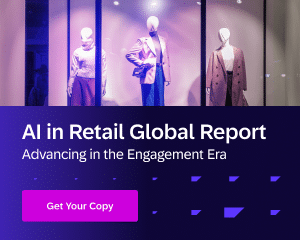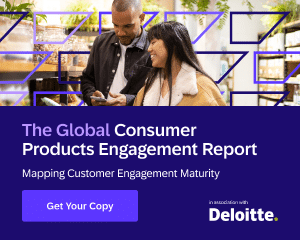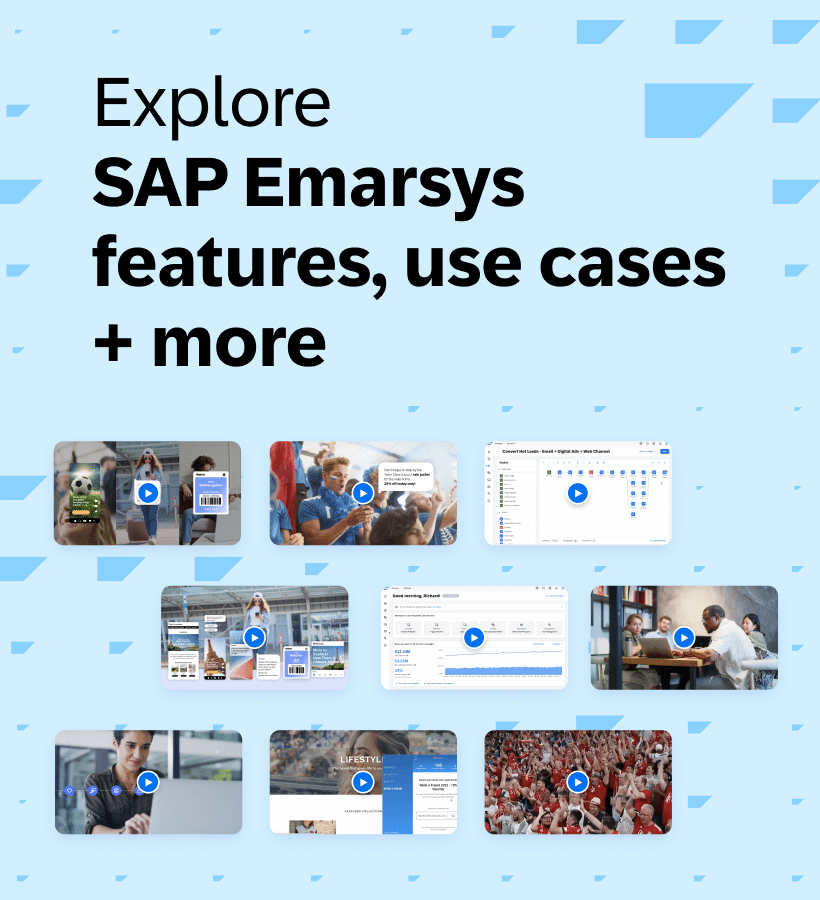Personalized marketing is a strategy businesses use to tailor their communications to individual customers based on data about their preferences, behaviors, and previous interactions.
How do Businesses Create a Personalized Experience?
These personalized experiences can be created by analyzing customer data to deliver more relevant content and product recommendation. The goal of personalized marketing? To truly engage your audience by communicating with each as an individual with content that feels like it was created just for them.
You’re right, this all sounds impossible. To help break down personalized marketing and provide more clarity around the term, we’ve outlined below the benefits, challenges, frequently asked questions, and Emarsys resources on the topic.
Why do Businesses Need Personalized Marketing?
There are numerous benefits of personalized marketing for both businesses and consumers. When strategies are implemented successfully, the following benefits come into play:
Improved customer experience
Customers are more comfortable providing personal information to their favorite brands if they get something in return. They fill out forms, download whitepapers, participate in surveys to get discounts, and indicate their favorite purchases or preferences. So, what’s the catch? With all of this customer data being offered, the consumer expects brands to protect any sensitive information and offer more personalized experiences when they come back.
Drive revenue
By identifying and responding to the preferred channel for each customer, companies can increase ROI. With the right automation technology, marketers can identify which channel customers engage with, then automatically follow up across channels as part of a high value omnichannel marketing strategy.
Increase brand loyalty
When consumers provide information and data, they expect to be treated as unique individuals with specific preferences. Businesses that dedicate time and resources to implement successful personalized marketing strategies will benefit from a competitive advantage in both brand loyalty and customer satisfaction.
Create consistency across channels
Consumers are interacting with brands across a number of channels, including email, social, mobile, etc., sometimes all in a single day. For this reason, it’s more important than ever for brands to create a consistent customer experience across all channels. The in-store experience should match the app experience, which should match email messaging. You get the point.
Challenges of Personalization in Marketing
Like all marketing strategies, there are challenges that arise when it comes to personalized marketing. Let’s take a look at some of the most common hurdles:
- Finding the right technology. One of the biggest problems with personalized marketing comes from outdated technology that is not fit for the mobile era. A key element of personalization success is customer data collection and automation, and with this comes the need for an intelligent algorithm. Unfortunately, many marketers struggle to find a smart personalization engine that meets their needs.
- Time and resources. While the right software is needed for personalization, companies also need a devoted team. Not all companies are prepared to dedicate the time and resources toward a successful personalized marketing strategy.
- Creating a single customer view. When looking for common threads across channels, marketers are able to establish a better picture of who the customer really is by piecing together their customer data into a single unified customer profile. However, research shows that marketers have trouble linking data to individual customer profiles.
Implementing smart segmentation. Smart segmentation across channels isn’t just for show, it actually boosts performance. Unfortunately, many marketers still struggle to get past basic segmentation strategies. In fact, 85% of brands agree their segmentation strategy is based on broad segments and simple clustering, according to Adweek.
How to Create a Successful Personalized Marketing Strategy
No one said it was easy. When launching a successful personalized marketing strategy, the following should be considered:
- Compare: To start, if you’re not using any kind of content personalization engine, you should be. If you are already leveraging a personalization platform, make sure to compare your existing solution against any other that claims to offer more value.
- Capture: Typically, the implementation of this type of personalized marketing solution is fairly easy (requiring only a few lines of code on your webpages). Once code has been added to your website, you can start capturing data, including clicks, time on site, abandoned shopping carts, purchase history, and much more.
- Analyze: Capturing data, building analytical capabilities, and developing adaptable websites are all beneficial to an organization, but they are most valuable when fully synchronized with each other. After just a few short weeks, your personalization solution should be able to provide relevant content recommendations to customers. This is when you should run an A/B test to validate the performance of your system vs. a control.
- Act: Data collection and analysis inform your marketing decisions, but you should still let the machine do the heavy lifting. Don’t play with the calculation method more than necessary (for example: new promotions, out of stock products, etc).
Examples of Personalized Marketing Campaigns
Nowadays, the average consumer is fully expecting personalization in every campaign your brand runs. Here’s a look at some examples of personalized marketing campaigns that can lead to a great deal of success.
Marketers are using personalization to jumpstart their email campaigns. Through personalized marketing, marketers can create and send individualized emails to a specific group with certain needs.
Getting a better understanding of your audience is key to increasing the relevancy of email content.
One way to start collecting customer information is through sign-up forms. When someone signs up, they would fill out a form with details about themselves that could range from their birth date to particular interests. This valuable first-party data can then be used to segment your audience and power personalization. For example, a clothing retailer might send emails based on age and interests to potential customers to determine what clothing styles they would like best.
Custom video messages
Did you know that the average online reader loses interest in about 15 seconds or less? Leveraging videos with custom messaging can be a very effective approach to keep customers engaged. Perhaps you’ve seen the dancing holiday elves before – you can add a picture of yourself and friends, then watch as the elves boogie down with your faces on them.
Or, social media videos that show your name and personalized information that you might’ve included in your profile. Although this type of personalization is memorable for your audience, it can be time-consuming without the right automation technology in place. So, be sure that you have the tools and resources needed to make this as scalable as possible.
Product recommendations
This is a pretty common tactic and for good reason – it works. This type of campaign uses data collection to determine what type of product, service, or offer a user is most likely interested in and tailor’s recommendations accordingly.
Say the last three movies you watched were all drama, it wouldn’t make sense if you were recommended the latest Adam Sandler film. Similarly, customers have the ability to rate these campaigns and provide feedback based on whether they enjoyed it or not. This allows customers to filter through what they like and don’t like much easier without having to go through the trouble watching everything.
Social media marketing
Interacting with consumers and potential customers across social media networks can help increase customer satisfaction and brand loyalty. Not surprisingly, social media has quickly become the backbone of multichannel marketing initiatives and has helped continue conversations online that keep brands in the minds of potential customers. By sending highly personalized and relevant social media messages through automation, marketers are able to collect responses and customer data from social media channels, which in turn helps improve communication and drive conversions.
Fear of Missing Out (FOMO)
Want to know what really drives conversions? Fear – or fear of missing out to be exact. As humans, we aggressively seek out information that could be deemed vital and get an uneasy feeling when we sense we’re missing out on something special. By showing how many other people are currently looking at this same product or have bought it recently, e-commerce sites are incorporating FOMO personalized messages as a way to convince customers that they need to make a purchase before leaving. These messages are oftentimes brief and to the point, while requiring very little effort from a marketers’ standpoint.
6 Personalized Marketing Statistics & Trends
We’ve talked a lot about how personalization can help marketers drive conversions, boost engagement and improve customer loyalty, but where are the facts to back it up? Seeing is believing, right? Here are 6 personalized marketing statistics that have turned even the biggest skeptics into believers.
1. Customers increasingly demand personalized experiences
Customers don’t just want personalization – they demand it. In fact, customers feel frustrated when website content is not personalized. Marketers must take that into account as personalization represents a huge portion of customer satisfaction. In fact, a study by Twilio found that 66% of consumers will abandon a brand if they don’t get a personalized experience.
2. Consumers seeing personalized content are more likely to purchase
Did you know 63% of consumers are more likely to make a purchase from a brand that provides relevant and personalized content? That means that creating engaging, personalized content can be the difference between pretty much doubling your potential customers’ purchase rate.
3. Emails with personalized subject lines are opened 30% more
Emails with personalized subject lines are more likely to be opened. In fact, research has shown that on average, personalized subject lines can increase open rates by 29.5%. Personalization makes content marketing messages feel more customized to the individual. By leveraging the data you’ve collected from your audience, you can drive open rates while increasing the overall effectiveness of your marketing efforts.
4. Purchases are more likely from personalized emails
Personalized emails deliver a 6 times higher transaction rate than non-personalized emails, but brands fail to properly use them. While this is a challenge that comes along with delivering personalized emails, the pros should far outweigh the cons. Numbers don’t lie and brands should adjust their campaigns accordingly.
5. Personalization leads to happier customers
Any business searching for a way to drive conversions and improve customer satisfaction need not look further. PwC found businesses that prioritize personalization see a 16% increase in customer satisfaction scores and a 19% increase in sales. This shows going the extra mile really pays off.
6. AI-Powered Personalized Marketing
AI-powered personalized marketing is all the rage in marketing buzzword bingo at the moment and for good reason. It leverages artificial intelligence (AI) and machine learning (ML) technologies to create more targeted, relevant, and personalized marketing experiences for individual consumers.
This type of marketing aims to enhance customer engagement, improve conversion rates, and foster customer loyalty by understanding and addressing the unique preferences, behaviors, and needs of each consumer. A McKinsey study found companies using AI-powered personalization have seen a 6-10% increase in sales, on average.
Personalized Marketing FAQs
There are some common questions that come up around personalized marketing. We’ve outlined some of the ones we hear most often below:
Why is personalized marketing important?
With technological improvements, customer expectations are evolving. When customers provide their personal information, they want to be treated as an individual with unique traits. As marketers, we need to provide the information that customers want, in the right place and at the right time.
How does personalized marketing benefit businesses?
Personalized marketing helps businesses by improving customer engagement, increasing conversion rates, and fostering loyalty. It enables brands to deliver relevant content and experiences, leading to higher customer satisfaction and retention. Additionally, personalized strategies can boost sales, enhance marketing ROI, and differentiate businesses in competitive markets.
How do I measure personalized marketing efforts?
Similar to any marketing campaign, there are many ways to measure the effectiveness of personalized marketing campaigns. Using intuitive reporting dashboards is especially important when it comes to understanding and targeting your customers. With advanced reporting and insights, you have the ability to measure the performance of your strategy and the direct impact on business.
How does personalized marketing impact the customer experience?
Great question! The key here is that personalized campaigns turn browsing customers into buying customers. Customers are continuously seeking great buying experiences, and delivering individualized content to recipients strengthens the relationship between businesses and their consumers.
What’s the relationship between personalized marketing and omnichannel marketing?
Basically, personalized marketing strategies support the broader objectives of an omnichannel approach. By understanding the preferred channel for each contact, marketers can automatically follow up across channels as part of a coordinated omnichannel marketing strategy.
What strategies can be used to implement personalized marketing?
Strategies to implement personalized marketing can include data analysis to understand customers’ preferences and behaviors, content personalization to provide relevant offers, and utilizing technology like artificial intelligence (AI) and machine learning for predictive personalization. Other methods may include email marketing, social media customization, and one-on-one personal interactions with clients.
Are there specific industries or types of businesses that benefit most from personalized marketing?
Industries such as retail, e-commerce, hospitality, and any business that relies heavily on customer interaction and engagement tend to benefit the most from personalized marketing as it allows them to directly target and fulfill individual customer’s preferences and needs.
Embrace Personalization for Lasting Customer Connections!
Consumers demand more personalization throughout the buying journey now more than ever. If your personalized marketing strategy isn’t properly tailored to each and every individual, they won’t feel engaged and therefore are less likely to purchase from you. Having a successful personalized marketing strategy in place can be the greatest asset your business has to offer.







